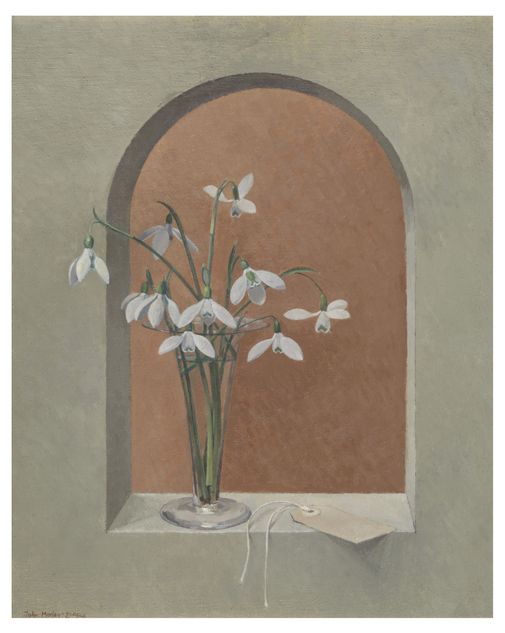Oh, to be a galanthophile. To spend weeks, months and years looking at catalogues, picking out varieties and planting thousands upon thousands of bulbs, all for those few short weeks—from late January through to April—when the snowdrops appear, nod their heads and die back until next spring.
To the average bystander like myself, all snowdrops look rather the same: a thin green stem with a pendulum of white hanging below. But to the artist John Morley and other galanthophiles, there is a world of difference between cultivars where the leaves sit flush against each other (“Odd Scharlock”) or roll up into flirtatious curls (“Bumble Green”); those with paintbrush smudges of green up their petals (“Papageno”) or a startling all-white brightness (“Fly Fishing”); those with double flowers, reminiscent of the shape of a fairy’s teacup (“Flocon de Neige”); and those with a rather more sombre, modest downward turn.
The snowdrops in Morley’s painting, Snowdrops in a Glass (2005–6), are difficult to identify. They have petals that spread themselves out into wings; delicate, round green caps where the flower meets the stem; long, slim forms abound. Are they “Early to Rize”? Or perhaps the poetically named “Lady with the Lamp” (so-called in an ode to Florence Nightingale)? They could be any number of the 300 kinds which Morley—snowdrop-breeder and “painter-plantsman”—grew at North Green, his snowdrop nursery in Beccles, East Suffolk.
Now, with the artist aged 83, Morley’s work is the subject of a gem of an exhibition at Lambeth’s Garden Museum. In one small room, it tells the story of this artist-gardener’s life and career, from his time studying under Edward Bawden at the Royal Academy through to his days mingling with the artistic, horticultural bohemia of Benton End, the East Anglian country house and art school owned by his good friend Cedric Morris.
Morley was, and is, a collector of all sorts of rare plants: unusual daffodils, dark fritillaries and bright auriculas—all of which he paints with the care and precision of someone who has nursed them from seed to life. Across all the works on display, there must be more than fifty shades of green; everywhere the leaves are luminous. One painting, of Morley’s auriculas in terracotta pots, has the poise of dancers on a stage rather than plants on a windowsill. Another, of purple fritillaries in a vase against a storm-dark sky, seems to contain more drama than a gothic novel.
But, for all this profusion of green-fingered beauty, it was the simplicity of the snowdrops which stopped me: a plain trumpet vase, under an arch and against a terracotta background. A brown paper tag—the strings untied—lies next to it. Perhaps it would have told us the cultivar of the snowdrops, but was turned over to preserve their modesty? As with Morley’s other still lives—his majestic avocados and stately-serious fungi—there’s a stillness here; a sense of purpose, of attention paid to the mundane and everyday.
Could the sense of quiet dignity suggest something more than a simple plant scene? The white of the flowers; the structure of the arch. Looking at the work for longer, the forms started to take on new resonances in my eye. The classical architecture seems out of place; a nod to an older, southern Renaissance palette and scene. Suddenly, in this framing, these innocuous white flowers become something more. Perhaps a reference to the white lilies the archangel Gabriel is said to have brought Mary, at the moment he tells her she will be the mother of God? The terracotta arch—so un-English, so un-East Anglian—is borrowed from those older religious paintings, where the holy spirit is usually depicted streaming through the right-hand corner. Could Snowdrops in a Glass be an unlikely 20th-century Annunciation painting? The herald of something new, something radical being born?
In the absence of the Virgin Mary, that newness appears to us in the guise of the humble snowdrops. Spring, with its earth-changing magic, is coming.
John Morley: Artist Gardener is on display at the Garden Museum until 20th April














